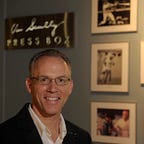On This Date: Lasorda’s opening act, Frank Sinatra
by Mark Langill
Only a supremely confident and exuberant Tommy Lasorda could’ve accepted what felt like a lifetime achievement award on his first Opening Day as a Major League manager when Frank Sinatra sang the national anthem on April 7, 1977.
In the six-month transition period after replacing Walter Alston, Lasorda had announced the end of Cincinnati’s Big Red Machine dynasty that had won the previous two World Series. And Lasorda already felt sorry for the person who would one day have to replace him as Dodgers manager — his answer to whether he felt pressure replacing Alston, who won four World Series and seven NL pennants in 23 seasons.
But Sinatra’s presence on April 7 prior to the Giants-Dodgers opener at Dodger Stadium wasn’t a cameo appearance or simply fulfilling a promise to Lasorda if he ever landed his dream job. Sinatra’s six-decade association with baseball was bookended by his friendships with two Hall of Fame Dodger managers: Leo Durocher in Brooklyn and Lasorda in Los Angeles.
Both were scrappy ballplayers in their day — Durocher a light-hitting shortstop; Lasorda a left-handed pitcher whose best days were in Triple-A Montreal. Neither avoided a fight nor the chance to stand in front of a camera. When they became Dodger managers, Durocher and Lasorda each wallpapered their office with photos of their movie-star friends. When Durocher returned to the Dodgers as a Los Angeles coach in the 1960s, he appeared on numerous sitcoms like “The Munsters” and “Beverly Hillbillies” as the de facto Dodger manager because Alston didn’t care about Hollywood.
Lasorda wore uniform No. 52 between 1973 and 1976 as a third-base coach under Alston. He switched to No. 2 in honor of Durocher, who guided Brooklyn in 1941 to its first pennant in 20 years. When Durocher was posthumously elected to the Hall of Fame in 1994, his plaque at Cooperstown depicted “Leo the Lip” in a Brooklyn cap. But the Dodgers didn’t retire Durocher’s number because Lasorda was still wearing it. Lasorda’s uniform No. 2 was retired in 1997 upon his elected to Cooperstown.
Durocher managed four teams for 24 seasons, including the 1951 Giants which overcame Brooklyn’s 13 1/2 game lead and won the pennant. Sinatra was sitting with actor Jackie Gleason at the Polo Grounds when Bobby Thomson belted his walk-off, ninth-inning home run off Ralph Branca in the third and deciding playoff game.
As Dodger manager in 1944, Durocher had welcomed 30-year-old Sinatra to Ebbets Field for an April 14 preseason exhibition game between Brooklyn and the Philadelphia Phillies to benefit the American Red Cross. Fundraising events at ballparks were commonplace during World War II. Sinatra sang three songs: “Take Me Out to the Ballgame,” “Let Me Call You Sweetheart,” and “People Will Say We’re in Love.”
In 1949, MGM planned to make a musical, “Take Me Out to the Ballgame,” with Sinatra, Gene Kelly, Esther Williams and Betty Garrett. The plot centered on three teammates in the early 1900s who are also entertainers in the offseason. Sinatra lobbied director Busby Berkeley to include Durocher as the third player, but the role went to actor Jules Munshin. Durocher was so grateful for the opportunity to audition his acting and singing skills that he arranged a tutoring session with Yankees shortstop Phil Rizzuto so Sinatra would look good portraying a second baseman.
The Sinatra-Durocher friendship continued in the 1960s when both lived in the Palm Springs area. In Gay Telese’s iconic “Frank Sinatra Has a Cold” profile for Esquire Magazine in 1966, the author describes the singer and other characters in a private club in Beverly Hills, noting Durocher is playing pool in the other room. When Durocher underwent open-heart surgery in 1979, Sinatra supervised his medical treatment and recuperation period.
Lasorda’s first extended visit with Sinatra occurred in 1976 after comedian Pat Henry invited Lasorda to Chicago, where Henry was opening for Sinatra. They spent time together at the hotel and discussed their love of baseball and Italian pasta.
“For me, this was like meeting Babe Ruth or the President of the United States,” Lasorda said. “When I was growing up, I idolized Frank Sinatra. I was so proud of him, an Italian boy like me, the son of immigrants like me, from a poor family like me, growing up to be cheered by millions and millions of people.
“Frank Sinatra, I found out, had been an outstanding Dodger fan since Leo Durocher had been one of Walter Alston’s coaches. So we talked baseball for a while and he said, ‘You should be managing the Dodgers.’ That was always a tough spot for me to be in. I didn’t want anyone to believe I had anything but the utmost respect for my boss, so I gave him the stock answer, ‘If the Lord is willing, I will be someday.’”
Lasorda’s proudest moment was Sinatra visiting his mother in the family’s Norristown, Pennsylvania, home. Carmella Lasorda had suffered a stroke and Sinatra wanted to boost her spirits. Carmella cooked for Sinatra and sent him on his way with extra food. Days later, Sinatra sent a limousine with a medical staff to pick up Carmella as his guest at a concert. He gave her flowers and introduced her to everyone. The night was a success, but Lasorda needed to give Sinatra more than a “thank you.”
“I had to call Frank and remind him my mother wanted her food containers back,” he said.
